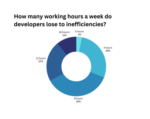
Slack has become a place where developers can find an app for handling almost any task, or they can build their own easily. Bear Douglas, director of developer relations at Slack, has noticed that more and more, developers are no longer just building tools for themselves, but recognizing the value they’ve received from these tools and asking what value they could provide to their whole team.
To make building apps even easier, Slack recently released Workflow Builder, which is a WYSIWYG editor that allows users to create custom workflows to automate routine tasks. “We’ve seen that totally take off with users and the greatest thing with that as far as I’m concerned is that it means that this value that was essentially locked in our platform for developers, because you had to be conversant with how to use an API, is now starting to become something that everyone can tap into.”
RELATED CONTENT: Productivity tools are crucial in the current development landscape
One company that has created a custom bot in Slack to significantly increase productivity is Color, which is a population health technology company. They have a fully automated lab, and developed a bot that alerts lab workers when samples have been processed.
According to Justin Lock, head of R&D at Color, a traditional lab is made up of a number of robots, with humans competing various tasks between them. But this isn’t a particularly effective way of getting things done, Lock explained.
There are two steps that Color needed to take to improve their lab. First, they brought the robots into a small envelope, allowing them to pass things (both information and physical objects) among each other. Second, the robots need to communicate with humans to communicate what part of the process they are at so the humans know what needs to happen next.
To accomplish this, they turned to Slack. “We were using Slack within the company to communicate between each other and so we thought, you know, we’re always on Slack anyway, is it possible to get these robots to just ping us and tell them when they’re done via Slack,” said Lock.
Lock explained that Slack’s website has a number of resources, like comprehensive instructions on how to build different bots and how to integrate with the Slack infrastructure. He added that the person on their team who created the bot wasn’t even a software engineer; he was a mechanical engineer. “He was able to write the executable, design the kill script, and within probably two days of trial development, we were able to start pinging each other via robots in the lab.”
Lock believes that the products that companies build are usually a reflection of their company culture. For Color, their goal is to provide high-quality clinical genomics and affordable, efficient, high throughput testing. “When you think about delivering health care at scale, ensuring high quality, it becomes really important to think about how you’re actually building your infrastructure from the ground up so that it’s efficient and scalable,” said Lock. “And I think historically we’ve seen that’s something that hasn’t been prioritized by a lot of organizations. And so Color has spent a lot of time and energy really thinking deeply about each step in our lab process and subsequent downstream processes to make sure that the data we’re generating is as high quality as possible and also as efficient as possible. And just generally being able to use software tools like Slack and others, just really enabled us to scale.”






